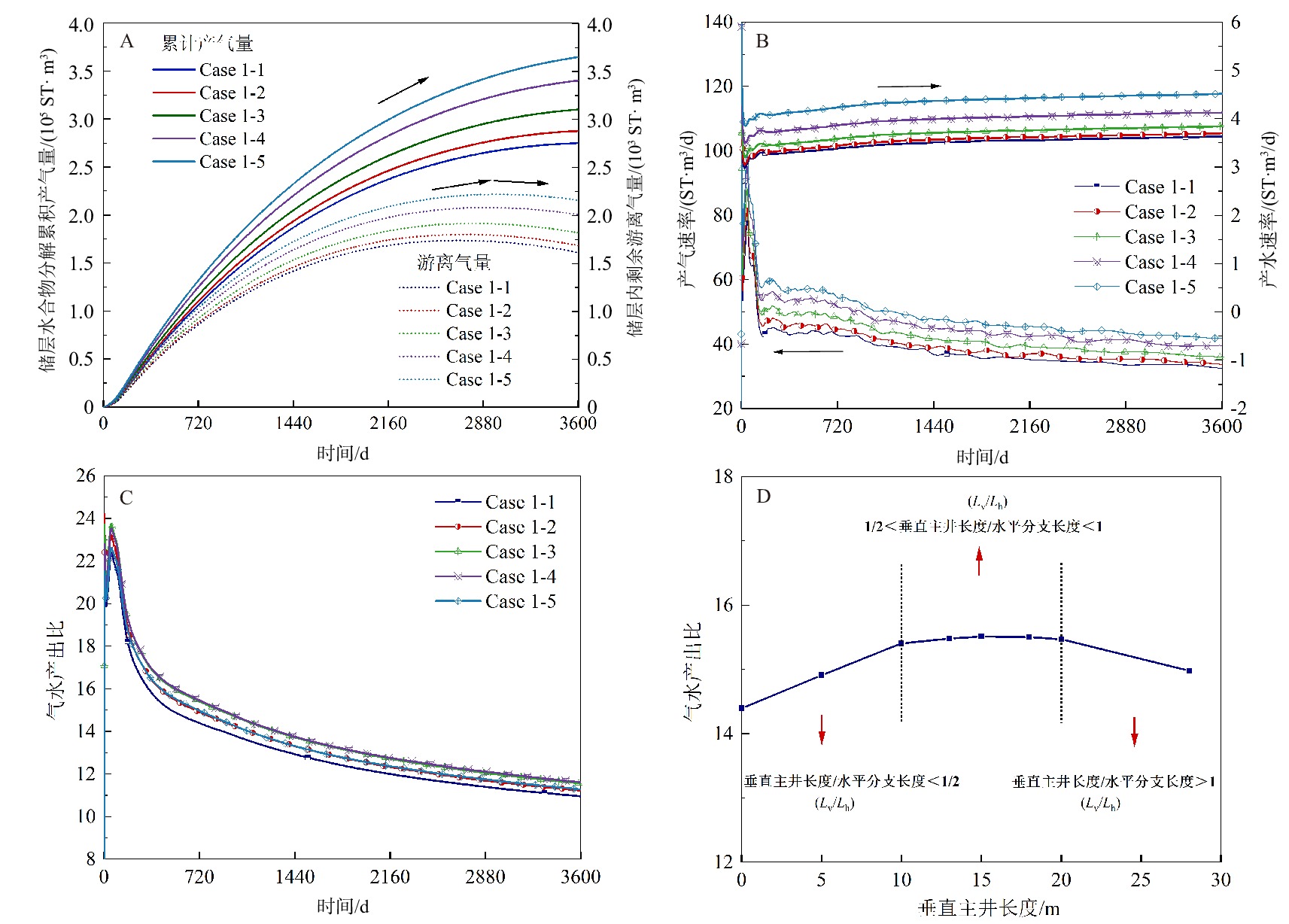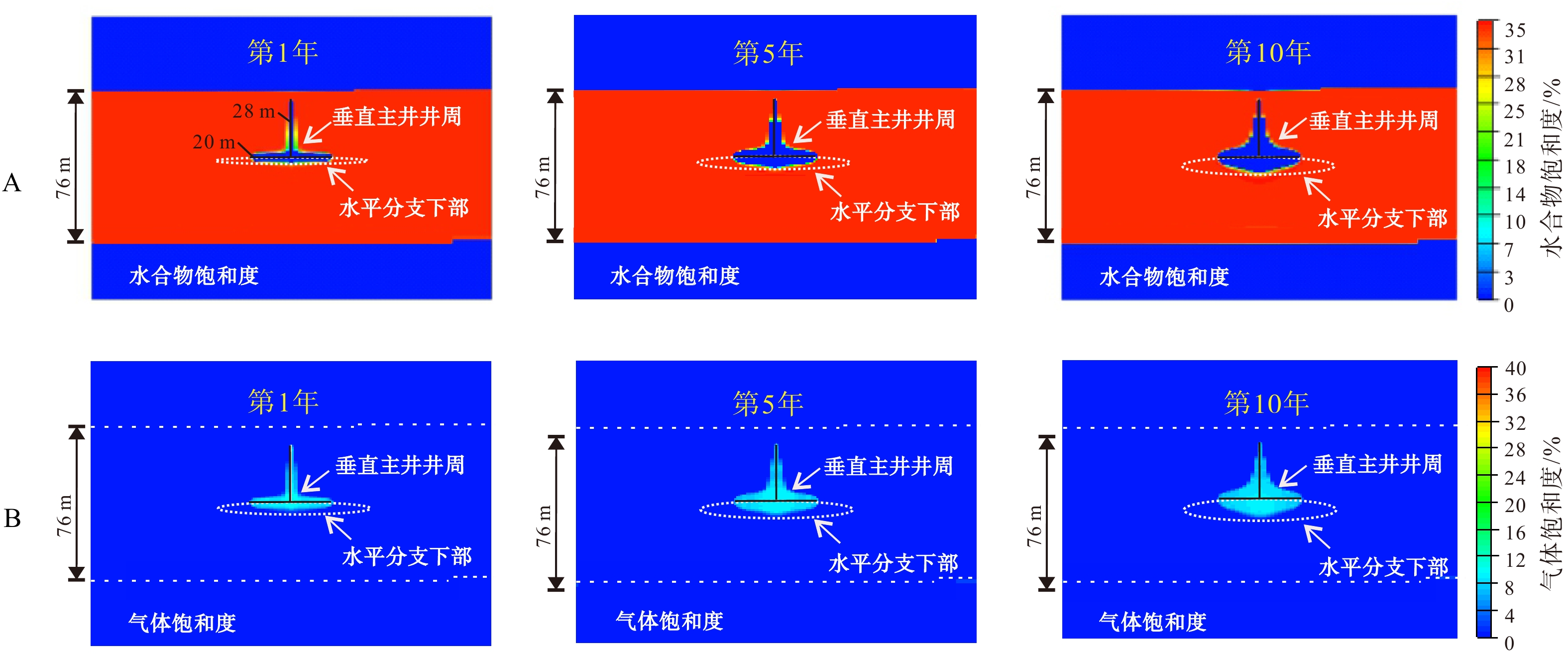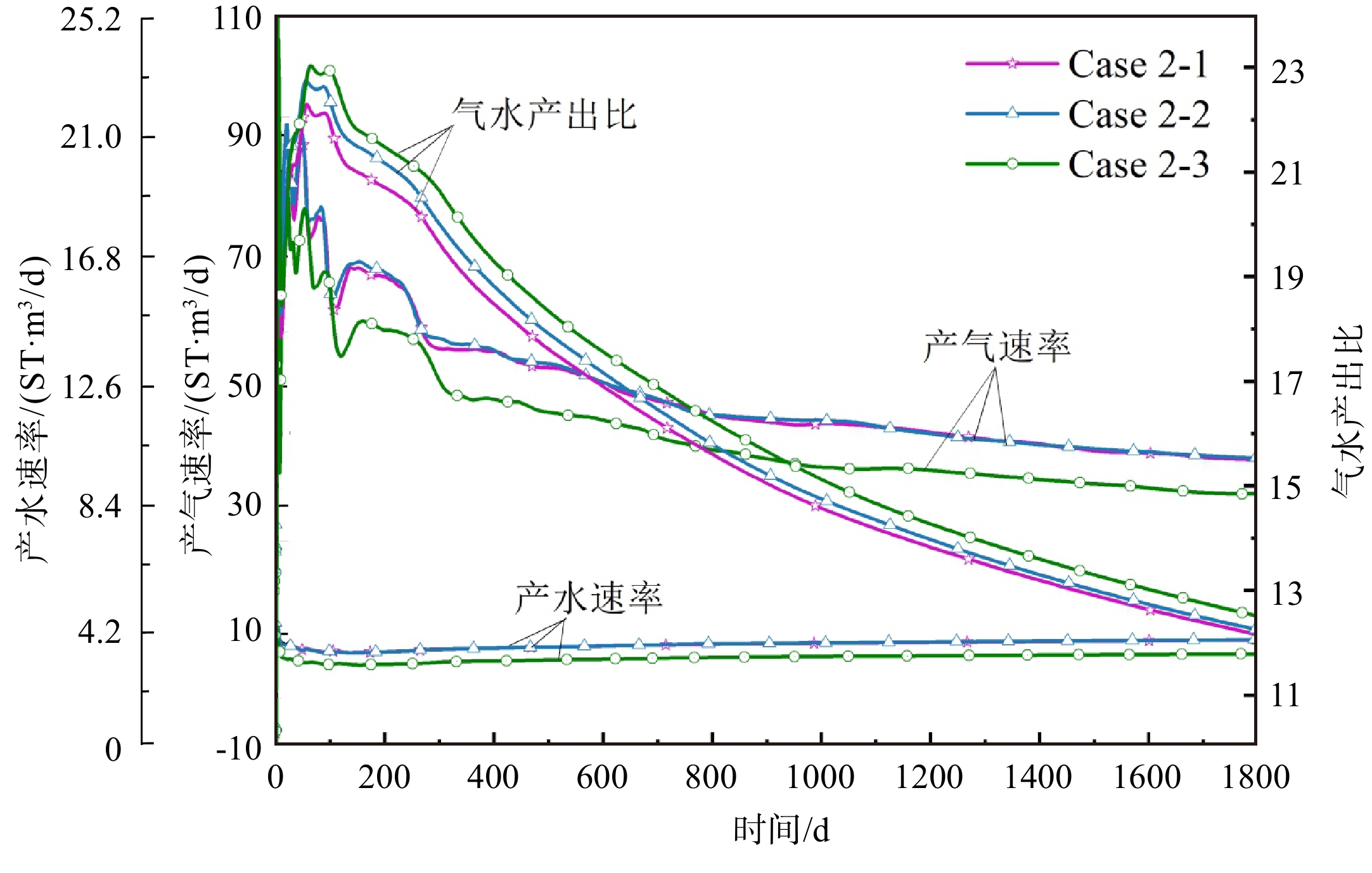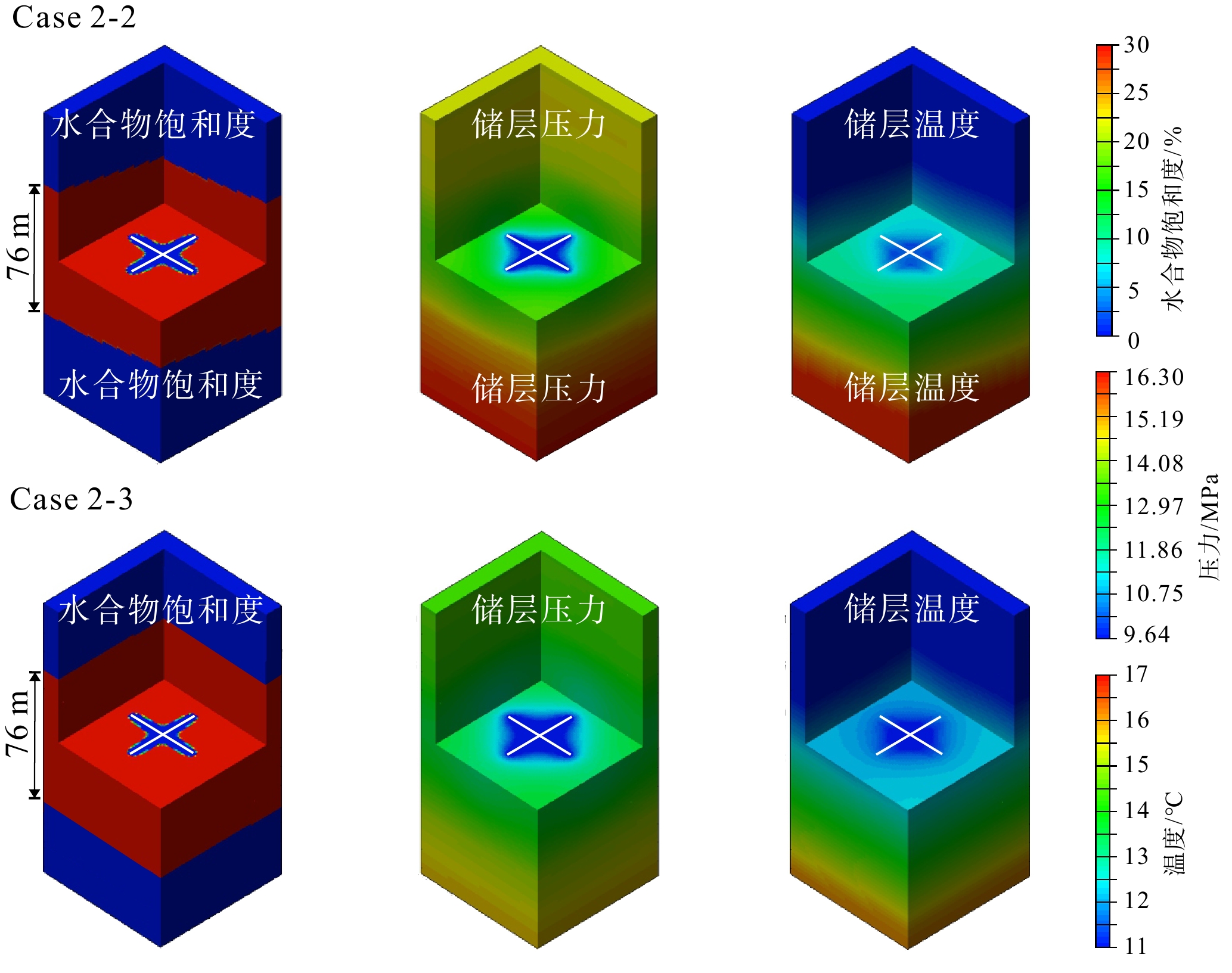Effects of perforation degree and deployment position of multilateral horizontal wells on gas production from inclined clay hydrate reservoirs
-
摘要: 南海天然气水合物(以下简称水合物)较多赋存于凹凸起伏的泥质地层中。针对实际倾斜水合物储层展开多分支井产能研究十分必要。以南海北部神狐海域X01站位实际地质参数和地形参数为依据,利用TOUGH+HYDRATE水合物产能预测软件和经过验证的建模新方法,建立了代表实际情况的倾斜泥质水合物储层模型,探讨了多分支井射孔程度对开采产能的影响,对比了位于储层不同构造位置(即构造低部位、倾斜部位和构造高部位)的多分支井的产能差异,确定了优势开采井型和最佳布井位置。结果表明,相比于仅水平分支射孔的多分支井,水平分支和垂直主井同时射孔的多分支井更利于水合物分解产气。但垂直主井的打开长度不宜过长,垂直主井与水平分支的打开长度比值介于0.5~1.0最利于提高气水产出比。泥质水合物储层的地层倾角影响多分支井的开采产能,将多分支井布设在储层构造低部位的水平位置更利于实现水合物长期高效开采。Abstract: Natural gas hydrate (NGH) is generally disseminated in inclined mud sediments in South China Sea (SCS), China. It is of great significance to investigate the production performance of multilateral horizontal wells in actual inclined NGH reservoirs. We implemented a real 3D inclined clay hydrate reservoir model based on geological and topographical data from the site X01, Shenhu Area, SCS, to simulate the production performance of multilateral horizontal wells with TOUGH+HYDRATE software and verified the modeling method. We studied the effects of perforation degree on the production performance of multilateral horizontal wells. The differences in production were compared when multilateral horizontal wells were deployed at different tectonic settings of NGH reservoirs (i.e., structural high position, inclined position, and structural low position). The optimal well configuration and placement position were determined. Results show that multilateral horizontal wells that are perforated simultaneously in horizontal branch and vertical main well are beneficial to enhance NGH dissociation and gas production. However, the perforation section of vertical main wells should not be too long. The optimal length ratio of vertical main well and horizontal branch is 0.5~1.0. Moreover, the inclination of the hydrate reservoirs affects significantly the production performance of multilateral horizontal wells. Comparatively, deploying multilateral horizontal wells at horizontal places at low structural positions of clay hydrate reservoirs is conducive to long-term and efficient production of NGH.
-
全球约90%以上的天然气水合物(以下简称水合物)都赋存于海底浅层含泥质沉积物中[1],由于储层渗透性差,曾一度被认为是不适宜开采的矿体。2017和2020年,我国在南海北部泥质粉砂型水合物储层中成功实施两轮试采,证明了泥质储层中的水合物也具备一定的技术可采性[2-3]。然而,平均约3×104 m3的日均产气量离工业气流标准还有很大差距,开采效率亟待提升[4-5]。因此,加强我国南海北部海域水合物增产研究非常必要。
水合物开采产能主要受到储层等地质因素的制约和开采井配置等工程因素的影响[6–11]。理论研究和实际试采结果均表明,与垂直井相比,水平井因有效扩大了分解面积而可获得更高产气速率[12–14]。但超长井段水平井在水合物储层中的应用仍受成本和技术难度的限制[14]。以多分支井为代表的复杂结构井被认为是实现水合物产能提升的关键[5,14-16] 。然而,降压开采过程中多分支井不同射孔井段的协同降压会干扰储层中的传热传质[17]。虽然目前已基本明确水平分支射孔程度对产能的影响规律[18],但垂直主井同时射孔及其射孔程度对多分支井开采产能的影响仍不清楚。
此外,储层特性对海域水合物产气、产水能力制约明显[19]。现已初步探明储层孔隙度、渗透率等条件控制下的产能演化规律[20-22,12,23–25],地层倾角作为水合物储层非均质性的重要构造特征之一[13],已逐渐引起学者们的重视[24,26]。大量地震调查和实地钻探数据均显示海域水合物通常赋存于海底凹凸起伏的地层中[27-29]。相关研究表明,地层倾角使得水合物储层的初始温压场分布特征产生差异[27],进而影响水合物开采过程中的流体运移和生产行为[24,30],尤其是水在储层孔隙中的分布及流动性[31-32]。此外,倾斜水合物储层在开采过程中也更易发生变形,进而对开采井的稳定性和产能造成负面影响[30]。学者们认为,在日本倾斜水合物储层的生产过程中,位于储层构造高部位的流体因地层存在倾角发生了破坏性流动,进一步损坏了防砂装置,导致地层严重出砂,从实际证明了地层倾角的存在会对水合物开采行为造成显著影响[33]。我国南海北部神狐海域泥质水合物储层(如SH2、W11、W17和W19站位)主要分布于峡谷地区[34]。地层倾角也可能会对该区域泥质水合物储层的开采产能造成影响。然而,目前与此相关的研究开展较少,还未能清晰刻画南海北部具有倾角的泥质水合物储层的开采过程。多分支井降压开采条件下,倾斜泥质水合物储层的长期开采响应行为和产气产水规律仍不明确。
基于已形成的复杂水合物储层建模新技术和复杂结构井建模新方法[18, 26],本研究以南海北部神狐海域X01站位水合物储层的地质参数和地形参数为依据,建立了代表实际情况的倾斜泥质水合物储层模型,通过TOUGH+HYDRATE水合物产能模拟软件进行数值模拟研究。首先,探讨垂直主井是否射孔及射孔程度对多分支井开采产能的影响和增产效果,确定垂直主井和水平分支的最佳打开长度比值,优选多分支井井型;然后,考虑储层倾角作用下重力分异对水合物开采的影响,揭示位于储层不同构造位置(即构造低部位、倾斜部位和构造高部位)的多分支井的降压开采响应规律,确定优势布井位置。上述研究可深化海域倾斜泥质水合物开采传热传质与产气规律认识,为后续试采和开采工程设计提供一定的理论基础和工程依据。
1. 数值模型
1.1 3D倾斜储层模型建立和网格划分
中新世以来,南海北部神狐海域进入构造沉降期,高沉积速率为水合物的赋存创造了良好的地质条件[35-36]。2015年,广州海洋地质调查局(GMGS)在神狐海域进行了GMGS3科考,获取了高质量的地球物理测井资料和水合物岩心样品[34]。调查结果显示,神狐海域海底温度大约为3~6 ℃,地热梯度为4.5~6.7 ℃/100 m。水合物层分布深度约150~400 m,厚度为10~80 m。平均水合物饱和度为20%~40%,最高达76%。神狐海域W17、W19等站位的水合物储层主要位于海底峡谷区的构造高部位或海脊边缘。其中,X01站位含水合物沉积物主要为黏土质粉砂或粉砂质黏土,水合物储层厚度为76 m,位于海脊顶部,见图1。根据多波束探测数据可知,X01站位西北区域地层倾角约为10°~15°。Wang等[37]对X01站位所在水合物层的空间分布研究结果认为,该区域的水合物储层近似平行于海底展布。
![]() 图 1 中国南海珠江口盆地和X01站位所在水合物储层的厚度示意图(A—B),多分支井结构示意图(C),基于实际地形参数和地质参数建立的倾斜3D储层模型及多分支井在储层不同构造部位的布设示意图(D)Figure 1. Map of Pearl River Mouth basin, South China Sea and thickness of gas hydrate-bearing sediments at site X01(A-B) ; the schematic diagram of a multilateral horizontal well configuration(C) and a inclined 3D hydrate-bearing reservoir model and schematic diagram of the layout of multilateral horizontal wells in different structural positions (D)
图 1 中国南海珠江口盆地和X01站位所在水合物储层的厚度示意图(A—B),多分支井结构示意图(C),基于实际地形参数和地质参数建立的倾斜3D储层模型及多分支井在储层不同构造部位的布设示意图(D)Figure 1. Map of Pearl River Mouth basin, South China Sea and thickness of gas hydrate-bearing sediments at site X01(A-B) ; the schematic diagram of a multilateral horizontal well configuration(C) and a inclined 3D hydrate-bearing reservoir model and schematic diagram of the layout of multilateral horizontal wells in different structural positions (D)本研究采用国际上最认可的TOUGH+HYDRATE水合物产能预测软件进行水合物开采产能模拟[38-39]。3D储层建模对网格数量和计算时间要求较高,基于前期确立的优势网格划分方案[18],本研究采用并行版TOUGH+HYDRATE软件(pT+H)[40],建立了与实际海底情况一致的倾角为10°~15°的3D水合物储层模型(1000 m(x)× 1000 m(y)× 312.5 m(z)),见图1D。考虑本研究主要探究实际水合物储层的倾角对开采产能的影响,建模时将水合物层设置为与海底地层平行分布且水合物饱和度一致。除地形参数外,3D倾斜储层的其他参数均参考X01站位的主要储层物性参数(表1)。此外,鉴于X01站位与神狐海域SH2站位的水合物储层物性相似,相对渗透率模型和孔隙水压力模型中经验参数的设定主要参考SH2站位水合物储层建模时选取的经验参数[41]。
参数 数值 参数 数值 储层基础参数 上覆盖层厚度/m 116.5 颗粒密度/(kg∙m−3) 2650 水合物储层厚度/m 76 地温梯度/(℃/100 m) 5.46 下伏地层厚度/m 120 热导率(湿)/(W∙m−1∙℃) 2.917 储层孔隙度/% 34.50 热导率(干)/(W∙m−1∙℃) 1.00 储层绝对渗透率/(10−3μ㎡) kx = ky = kz = 0.22 压缩系数/Pa−1 1.00×10−8 水合物饱和度/% 34.00 比热容/(J∙kg−1∙℃−1) 1000 X01站位处水深/m 1309.75 孔隙水盐度/‰ 3.05 相对渗透率模型(Relative permeability model) [39] KrA =(SA*)n KrG =(SG*)nG SA*=(SA−SirA)/(1−SirA) SG* =(SG −SirG)/(1−SirA) SirA 0.50 nG 3.00 SirG 0.05 n 5.00 孔隙水压力模型(Capillary pressure model) [42] Pcap = −P0[(S*)−1/λ−1]1−λ S* =(SA−SirA)/(SmxA−SirA) P0/Pa 105 SmxA 1.00 λ 0.15 SirA 0.50 根据以往经验,本研究在建模时,将上覆盖层和下伏地层厚度分别设定为 116.5 m和120 m,以满足热量和质量的交换[43-44]。多分支井的共面水平分支垂直于主井布设,位于垂直方向上的储层中部,套管射孔完井方式,各分支打开长度为20 m(图1C)。在x轴和y轴方向上,模型采用不等间距的划分方式。井眼附近传热传质比较剧烈,故在区域离散过程中,对井周网格进行了较为精细的划分:网格尺寸以0.1 m为主。其他储层的网格尺寸随着与开采井距离的增大而增大。在z轴方向上,水合物储层的网格尺寸设定为1.0 m;上覆盖层和下伏地层的网格划分主要遵循Moridis和Reagan[45]提及的划分规律,即储层的网格尺寸随着与储层距离的增大而规律性增大。储层上、下边界处的网格在z方向的厚度均为0.001 m。
1.2 初始和边界条件
X01站位水合物储层的初始孔隙压力随地层深度的增加而增大。在5.46 ℃/100 m的地温梯度下[34],储层初始温度从顶边界到底边界呈线性升高。海水密度平均为1023 kg/m3。3D储层模型的外围边界为绝热无渗流边界,上下边界均为恒温、恒压边界[46]。本研究涉及的水合物储层初始化细节参考前人研究[37,47-48]。完成模型初始化后,水合物储层底部温度为15.35 ℃;因地层倾角的原因,水合物层底部压力分布不一,最低压力为15.96 MPa(图1D为初始化后地层温度分布情况)。根据水合物的压力-温度平衡曲线认为水合物可稳定存在。
根据Moridis等[45]学者的早期研究,可将开采井单元作为一种“伪多孔介质”,并假定井内流动满足达西定律。该“伪多孔介质”的孔隙度值为1,渗透率设定为kr = kz = 5.0×10−9 m2,且毛细压力设定为Pc = 0。在模拟时认为开采井眼稳定、防砂可靠、出水已妥善处理。
1.3 井型结构与布设位置设计
先前研究证实,与一分支井、二分支井和三分支井相比,四分支井对泥质水合物储层的开采能力相对最高[18]。因此,本研究采用的多分支井为四分支井。如图2所示,为了探讨多分支井垂直主井是否射孔及打开长度对开采产能的影响和增产效果,共设计5个案例。Case 1-1代表多分支井的垂直主井不射孔,Case 1-2— Case 1-5的多分支井的垂直主井打开长度分别为5、10、20 和28 m,即射孔垂直主井长度与分支长度比值(Lv/Lh)分别为0.25、0.5、1和1.4。模拟时,5个案例的多分支井均布设于图1D中的较水平储层,以最大程度控制变量,减少构造条件对井型优选的影响。根据海域实际开采现场试验结果[44],设定多分支井采用4.5 MPa进行恒压开采。
确定最佳Lv/Lh后,将优选的多分支井部署在储层的不同结构位置进行降压开采,即将多分支井布设于储层的构造低部位(Case 2-1)、构造倾斜部位(Case 2-2)和构造高部位(Case 2-3)(图1D)。在考虑重力分异对水合物开采的影响下,对比开采产能差异,揭示倾斜水合物储层多分支井降压开采的响应特性和储层渗流规律,确定优势多分支井布设位置。
2. 模拟结果与分析
本文以产气速率、产水速率、气水产出比(即累计气体开采量与累计产水量的比值,水合物开采经济性评价相对指标)、储层水合物分解累计产气量和储层内剩余游离气量来综合对比不同开采方案下的产气产水规律及水合物储层响应特征。
2.1 垂直主井射孔程度对开采产能的影响
图3描述了垂直主井不射孔的多分支井(Case 1-1)和垂直主井射孔的多分支井(Case 1-2 — Case 1-5)降压开采条件下,储层产气量及井中产气速率、产水速率和气水产出比。
![]() 图 3 多分支井开采时,产气和产水的情况A. 储层水合物分解累计产气量和储层内剩余游离气量,B. 井中产气速率和产水速率,C. 井中气水产出比,D. 第720天,井中气水产出比。Figure 3. Gas and water production performance when hydrate-bearing reservoirs are produced by multilateral horizontal wellsA. Cumulative gas production volume from hydrate deposits and amount of free gas remaining in the reservoirs, B. gas production rate and water production rate in the production well, C. gas-to-water ratio in the production well, D. gas-to-water ratio in the production well at t = 720 days.
图 3 多分支井开采时,产气和产水的情况A. 储层水合物分解累计产气量和储层内剩余游离气量,B. 井中产气速率和产水速率,C. 井中气水产出比,D. 第720天,井中气水产出比。Figure 3. Gas and water production performance when hydrate-bearing reservoirs are produced by multilateral horizontal wellsA. Cumulative gas production volume from hydrate deposits and amount of free gas remaining in the reservoirs, B. gas production rate and water production rate in the production well, C. gas-to-water ratio in the production well, D. gas-to-water ratio in the production well at t = 720 days.从图3A中可以看出,无论采用何种多分支井开采泥质水合物储层,水合物分解累计产气量随着开采的进行而逐渐增大,但储层经过长期开采后,水合物分解累计产气量的增加幅度逐渐降低。这主要是由于:①随着水合物分解和吸热反应的发生,水平分支周围储层的温度明显降低,在一定程度上抑制了水合物的分解;②随着压降的传递和开采的进行,水合物分解前缘逐渐远离开采井,但储层渗透率极低,水合物分解范围主要集中于井周(图4A)。因此,水合物分解累计产气量的增幅逐渐减弱。从图3A还可发现,无论采用何种多分支井开采泥质水合物储层,储层内剩余游离气量随着开采的进行逐渐增多。但当开采时间超过约2 880 d时,储层的游离气量逐渐降低。此现象表明,多分支井的长期气体产出能力比短期气体产出能力更强。这可能是由于在开采后期,分支井周围储层的渗流能力因水合物分解而得到了提升,进而促进储层内游离气体的产出。如图4B所示,随着开采的进行,垂直主井井周和水平分支下部储层的游离气量逐渐增大,促进更多分解气从多分支井中产出。
![]() 图 4 降压开采第1、5和10年,Case 1-5案例储层中水合物饱和度(A)和气体饱和度(B)的分布图为了更好地呈现结果,主要呈现多分支井附近的物理场图,下同。Figure 4. Spatial distributions of hydrate saturation (A) and gas saturation (B) at t = 1 year, t = 5 year and t = 10 year in Case 1-5for clearly presenting situations, only the spatial distributions around the multilateral horizontal well are shown, same as below .
图 4 降压开采第1、5和10年,Case 1-5案例储层中水合物饱和度(A)和气体饱和度(B)的分布图为了更好地呈现结果,主要呈现多分支井附近的物理场图,下同。Figure 4. Spatial distributions of hydrate saturation (A) and gas saturation (B) at t = 1 year, t = 5 year and t = 10 year in Case 1-5for clearly presenting situations, only the spatial distributions around the multilateral horizontal well are shown, same as below .相比而言,当采用多分支井降压开采泥质水合物储层时,随着多分支井垂直主井打开长度的增加,储层水合物分解累计产气量和储层内剩余游离气量均增加。但对于X01站位这样具有极低绝对渗透率的海域泥质水合物储层而言,开采潜能并不十分理想,若要实施开采作用,还须结合其他辅助增产措施。本研究主要考虑多分支井垂直主井射孔程度和储层构造条件对多分支井开采产能的影响,暂不考虑将多分支井布设在低渗海域泥质水合物储层中的产量是否达到商业开采目的。
不同案例的井中产气产水规律随开采时间的变化较为规则,不同案例间的产能差异变化较小。从图3B中可以看出,由于地层渗透率极低,储层的降压产气效果较弱,即使是开采早期,多分支井的产气速率也比较低,主要为70~100 ST·m3/d。在130 d的模拟周期内,产气速率降低较快。而后,随着降压开采的进行,产气速率逐渐缓慢降低。与产气速率演变规律相反,不同案例的产水速率随着长期开采的进行而逐渐增加。但无论采用何种多分支井进行降压开采,产水速率的增幅并不十分明显,产水速率基本为3.5~4.5 ST·m3/d。图3C呈现了10 年开采时间内多分支井的气水产出比。从图中可以看出,开采早期气水产出比较高,尤其是130 d内的气水产出比(>20),但随着开采的进行,5个案例的气水产出比均呈现下降的趋势。
与Case 1-2—Case 1-5的产气产水结果相比,Case 1-1井中产气速率、产水速率和气水产出比均最低。随着垂直主井打开长度的增加,井中产气速率和产水速率相应增大。虽然水平分支下部储层的温压分布和水合物分解情况基本不受垂直主井射孔程度的影响(图5A—C),但相同开采时间内,垂直主井井周储层的压降范围和水合物分解范围随着垂直主井打开长度的增加而增大。因此,气、水产出速率随着垂直主井打开长度的增加相应增大(图3B)。但当垂直主井打开长度增大到一定程度后,增强射孔程度带来的产气增幅不如产水增幅明显,导致气水产出比反而随着垂直主井打开长度的增加而降低(图3C)。这可能是由于垂直主井射孔程度增强后,垂直主井与上覆盖层的距离更近,上覆地层中的水在开采过程中更易流入开采井(图5D),水流的增多导致垂直主井产气速率的增幅随其打开长度的增加而降低。
通过进一步对比相同开采时间(以开采第720天为例,图3D)内垂直主井射孔程度不同的多分支井的气水产出比可发现,当Lv/Lh<0.5时,气水产出比随Lv/Lh的增大而增大;当0.5<Lv/Lh<1.0时,Lv/Lh对气水产出比影响不明显,气水产出比值均较高,当Lv/Lh = 0.75时,值最大;当Lv/Lh>1.0时,随Lv/Lh的增大,气水产出比反而降低。因此,开采低渗泥质水合物储层时,Lv/Lh比值为0.5~1.0时,最利于提高多分支井的气水产出。
2.2 布设于不同构造位置的多分支井的产能差异
如上所述,随着垂直主井打开长度的增加,多分支井的产气速率逐渐增大。但当Lv/Lh为0.75时,多分支井的气水产出比最高。因此在本小节研究中,以垂直主井打开长度为15 m、水平分支打开长度为20 m的多分支井为例,对比布设于不同构造位置的多分支井的产能差异。
图6呈现了上述多分支井布设在泥质水合物储层不同构造部位时的产气产水情况。从图中可见,经过相同开采时间,不同案例中开采井的产气速率、产水速率和气水产出比随开采时间的变化较为规则。相比而言,Case 2-1和Case 2-2中的产气速率和产水速率均明显高于Case 2-3中的产气速率和产水速率。其主要原因是,在Case 2-3中水合物储层的埋藏深度较浅,水合物储层的初始温度和压力相对较低。在相同的开采条件下,Case 2-3中的水合物受到更弱的压降作用而发生分解反应,水合物分解范围更小(图7)。此外,虽然在开采过程中Case 2-2储层的压降比Case 2-3储层的压降更明显,但经过相同开采时间,布设于储层构造高部位的多分支井的井周储层温压明显更低(图7),在一定程度上抑制了水合物的进一步分解,故Case 2-3在开采时呈现出相对较低的气、水产出速率。在Case 2-1和Case 2-2两个案例中,尽管Case 2-2的储层初始温压较Case 2-1的储层初始温压条件低,但在开采过程中流体流动随时都受到重力分异作用的影响,导致Case 2-1和Case 2-2中的产气速率和产水速率相差不显著(图6)。
虽然多分支井布设于储层倾斜处和构造低部位时的产气、产水效果基本一致,但多分支井位于泥质水合物储层不同构造位置时,气水产出比存在差异。相比而言,多分支井布设于泥质水合物储层的构造高部位(Case 2-3)时,气水产出比最大(图6)。随着多分支井布设储层埋深的增加,气水产出比值逐渐降低。对比Case 2-1和Case 2-2的气水产出比可发现:①对于短期开采而言,将多分支井布设于储层倾斜处(Case 2-2),气水产出比较高;②对于长期开采而言,Case 2-1和Case 2-2的气水产出比逐渐趋于一致。水平井开采倾斜泥质水合物储层的研究指出,水合物分解易引起开采井发生变形、井周沉积物发生位移,进而影响开采安全和采收率[30]。采用多分支井长期开采具有倾角的泥质水合物储层时,采气安全也极可能受到倾角的影响。相比于倾斜地层,水平地层对实际水合物开采过程中井壁稳定性和储层稳定更有利,而产出水也可以依赖设备进行适当处理,故认为将多分支井部署在位于构造低部位的较水平泥质水合物储层可能更利于提高采收率。值得注意的是,对于渗透率极低的泥质水合物储层而言,仅采用降压法进行开采,多分支井的产气产水情况仍不理想,导致地层倾角对多分支井降压开采造成的产能差异的影响有限。若在海域低渗泥质储层中开展实际开采,势必会结合其他辅助增产措施,如储层改造技术。在联合开采技术的应用下,储层倾角的存在对开采产能造成的影响会更明显,尤其对于渗透率较大的泥质水合物储层,更应将多分支井部署在位于构造低部位的水平水合物储层中。此外,本研究仅考虑了多分支井射孔程度和布设位置对倾斜泥质水合物储层开采产能的影响,对于储层变形和非均质性对开采产能的影响在后续的研究中需进一步量化考虑。
3. 结论
(1)相比于仅水平分支射孔的多分支井,水平分支和垂直主井同时射孔的多分支井更利于水合物分解产气。但垂直主井的打开长度不宜过长,垂直主井与水平分支打开长度比值介于0.5~1.0时,最利于提高多分支井的气水产出比。
(2)海域泥质水合物储层的地层倾角影响多分支井的开采产能。将多分支井布设在储层构造低部位的水平位置更利于水合物的长期开采。但对于X01站位此类具有极低绝对渗透率的泥质水合物储层而言,开采潜能并不十分理想;若要实施开采作用,在将多分支井布设在优势构造储层进行开采的基础上,还须结合其他辅助增产措施,如井网开采模式和储层改造技术。
-
图 1 中国南海珠江口盆地和X01站位所在水合物储层的厚度示意图(A—B),多分支井结构示意图(C),基于实际地形参数和地质参数建立的倾斜3D储层模型及多分支井在储层不同构造部位的布设示意图(D)
图中A—B修改自Li等[2] 和Wang等[37],红色虚线框架表示本研究区域。
Figure 1. Map of Pearl River Mouth basin, South China Sea and thickness of gas hydrate-bearing sediments at site X01(A-B) ; the schematic diagram of a multilateral horizontal well configuration(C) and a inclined 3D hydrate-bearing reservoir model and schematic diagram of the layout of multilateral horizontal wells in different structural positions (D)
A-B are modified from Li et al [2] and Wang et al [37], red dotted frame is the research area of this study.
图 3 多分支井开采时,产气和产水的情况
A. 储层水合物分解累计产气量和储层内剩余游离气量,B. 井中产气速率和产水速率,C. 井中气水产出比,D. 第720天,井中气水产出比。
Figure 3. Gas and water production performance when hydrate-bearing reservoirs are produced by multilateral horizontal wells
A. Cumulative gas production volume from hydrate deposits and amount of free gas remaining in the reservoirs, B. gas production rate and water production rate in the production well, C. gas-to-water ratio in the production well, D. gas-to-water ratio in the production well at t = 720 days.
图 4 降压开采第1、5和10年,Case 1-5案例储层中水合物饱和度(A)和气体饱和度(B)的分布图
为了更好地呈现结果,主要呈现多分支井附近的物理场图,下同。
Figure 4. Spatial distributions of hydrate saturation (A) and gas saturation (B) at t = 1 year, t = 5 year and t = 10 year in Case 1-5
for clearly presenting situations, only the spatial distributions around the multilateral horizontal well are shown, same as below .
参数 数值 参数 数值 储层基础参数 上覆盖层厚度/m 116.5 颗粒密度/(kg∙m−3) 2650 水合物储层厚度/m 76 地温梯度/(℃/100 m) 5.46 下伏地层厚度/m 120 热导率(湿)/(W∙m−1∙℃) 2.917 储层孔隙度/% 34.50 热导率(干)/(W∙m−1∙℃) 1.00 储层绝对渗透率/(10−3μ㎡) kx = ky = kz = 0.22 压缩系数/Pa−1 1.00×10−8 水合物饱和度/% 34.00 比热容/(J∙kg−1∙℃−1) 1000 X01站位处水深/m 1309.75 孔隙水盐度/‰ 3.05 相对渗透率模型(Relative permeability model) [39] KrA =(SA*)n KrG =(SG*)nG SA*=(SA−SirA)/(1−SirA) SG* =(SG −SirG)/(1−SirA) SirA 0.50 nG 3.00 SirG 0.05 n 5.00 孔隙水压力模型(Capillary pressure model) [42] Pcap = −P0[(S*)−1/λ−1]1−λ S* =(SA−SirA)/(SmxA−SirA) P0/Pa 105 SmxA 1.00 λ 0.15 SirA 0.50 -
[1] Boswell R. Is gas hydrate energy within reach? [J]. Science, 2009, 325(5943): 957-958. doi: 10.1126/science.1175074
[2] Li J F, Ye J L, Qin X W, et al. The first offshore natural gas hydrate production test in South China Sea [J]. China Geology, 2018, 1(1): 5-16. doi: 10.31035/cg2018003
[3] 叶建良, 秦绪文, 谢文卫, 等. 中国南海天然气水合物第二次试采主要进展[J]. 中国地质, 2020, 47(3):557-568 doi: 10.12029/gc20200301 YE Jianliang, QIN Xuwen, XIE Wenwei, et al. Main progress of the second gas hydrate trial production in the South China Sea [J]. Geology in China, 2020, 47(3): 557-568. doi: 10.12029/gc20200301
[4] 刘昌岭, 李彦龙, 孙建业, 等. 天然气水合物试采: 从实验模拟到场地实施[J]. 海洋地质与第四纪地质, 2017, 37(5):12-26 LIU Changling, LI Yanlong, SUN Jianye, et al. Gas hydrate production test: from experimental simulation to field practice [J]. Marine Geology & Quaternary Geology, 2017, 37(5): 12-26.
[5] 吴能友, 李彦龙, 万义钊, 等. 海域天然气水合物开采增产理论与技术体系展望[J]. 天然气工业, 2020, 40(8):100-115 doi: 10.3787/j.issn.1000-0976.2020.08.008 WU Nengyou, LI Yanlong, WAN Yizhao, et al. Prospect of marine natural gas hydrate stimulation theory and technology system [J]. Natural Gas Industry, 2020, 40(8): 100-115. doi: 10.3787/j.issn.1000-0976.2020.08.008
[6] Wang Y, Feng J C, Li X S, et al. Influence of well pattern on gas recovery from methane hydrate reservoir by large scale experimental investigation [J]. Energy, 2018, 152: 34-45. doi: 10.1016/j.energy.2018.03.126
[7] Wang Y, Feng J C, Li X S. Experimental investigation into methane hydrate dissociation by thermal stimulation with dual vertical well [J]. Energy Procedia, 2017, 105: 4738-4744. doi: 10.1016/j.egypro.2017.03.1031
[8] Wang Y, Li X S, Li G, et al. A three-dimensional study on methane hydrate decomposition with different methods using five-spot well [J]. Applied Energy, 2013, 112: 83-92. doi: 10.1016/j.apenergy.2013.05.079
[9] Zhao E M, Hou J, Liu Y G, et al. Enhanced gas production by forming artificial impermeable barriers from unconfined hydrate deposits in Shenhu area of South China sea [J]. Energy, 2020, 213: 118826. doi: 10.1016/j.energy.2020.118826
[10] Zhao J F, Liu Y L, Guo X W, et al. Gas production behavior from hydrate-bearing fine natural sediments through optimized step-wise depressurization [J]. Applied Energy, 2020, 260: 114275. doi: 10.1016/j.apenergy.2019.114275
[11] 吴能友, 黄丽, 胡高伟, 等. 海域天然气水合物开采的地质控制因素和科学挑战[J]. 海洋地质与第四纪地质, 2017, 37(5):1-11 WU Nengyou, HUANG Li, HU Gaowei, et al. Geological controlling factors and scientific challenges for offshore gas hydrate exploitation [J]. Marine Geology & Quaternary Geology, 2017, 37(5): 1-11.
[12] Feng J C, Wang Y, Li X S, et al. Effect of horizontal and vertical well patterns on methane hydrate dissociation behaviors in Pilot-scale hydrate Simulator [J]. Applied Energy, 2015, 145: 69-79. doi: 10.1016/j.apenergy.2015.01.137
[13] Myshakin E M, Ajayi T, Anderson B J, et al. Numerical simulations of depressurization-induced gas production from gas hydrates using 3-D heterogeneous models of L-Pad, Prudhoe Bay Unit, North Slope Alaska [J]. Journal of Natural Gas Science and Engineering, 2016, 35: 1336-1352. doi: 10.1016/j.jngse.2016.09.070
[14] Wu N Y, Li Y L, Wan Y Z, et al. Prospect of marine natural gas hydrate stimulation theory and technology system [J]. Natural Gas Industry B, 2021, 8(2): 173-187. doi: 10.1016/j.ngib.2020.08.003
[15] 陈强, 胡高伟, 李彦龙, 等. 海域天然气水合物资源开采新技术展望[J]. 海洋地质前沿, 2020, 36(9):44-55 CHEN Qiang, HU Gaowei, LI Yanlong, et al. A prospect review of new technology for development of marine gas hydrate resources [J]. Marine Geology Frontiers, 2020, 36(9): 44-55.
[16] Li Y L, Wan Y Z, Chen Q, et al. Large borehole with multi-lateral branches: a novel solution for exploitation of clayey silt hydrate [J]. China Geology, 2019, 2(3): 331-339. doi: 10.31035/cg2018082
[17] Xin X, Li S, Xu T F, et al. Numerical investigation on gas production performance in methane hydrate of multilateral well under depressurization in Krishna-Godavari Basin [J]. Geofluids, 2021, 2021: 9936872.
[18] Mao P X, Wan Y Z, Sun J X, et al. Numerical study of gas production from fine-grained hydrate reservoirs using a multilateral horizontal well system [J]. Applied Energy, 2021, 301: 117450. doi: 10.1016/j.apenergy.2021.117450
[19] Huang L, Su Z, Wu N Y, et al. Analysis on geologic conditions affecting the performance of gas production from hydrate deposits [J]. Marine and Petroleum Geology, 2016, 77: 19-29. doi: 10.1016/j.marpetgeo.2016.05.034
[20] Moridis G J. Numerical studies of gas production from Class 2 and Class 3 hydrate accumulations at the Mallik Site, Mackenzie Delta, Canada [J]. SPE Reservoir Evaluation & Engineering, 2004, 7(3): 175-183.
[21] Reagan M T, Moridis G J, Zhang K N. Sensitivity analysis of gas production from Class 2 and Class 3 hydrate deposits[C]//Offshore Technology Conference. Houston, Texas, USA, 2008.
[22] Su Z, Moridis G J, Zhang K N, et al. A huff-and-puff production of gas hydrate deposits in Shenhu area of South China Sea through a vertical well [J]. Journal of Petroleum Science and Engineering, 2012, 86-87: 54-61. doi: 10.1016/j.petrol.2012.03.020
[23] Sun J X, Ning F L, Zhang L, et al. Numerical simulation on gas production from hydrate reservoir at the 1st offshore test site in the eastern Nankai Trough [J]. Journal of Natural Gas Science and Engineering, 2016, 30: 64-76. doi: 10.1016/j.jngse.2016.01.036
[24] Chen L, Feng Y C, Merey S, et al. Numerical investigation on gas production from Shenhu (China): Influence of layer inclination and horizontal Inhomogeneities [J]. Journal of Natural Gas Science and Engineering, 2020, 82: 103509. doi: 10.1016/j.jngse.2020.103509
[25] Xia Y L, Xu T F, Yuan Y L, et al. Effect of perforation interval design on gas production from the validated hydrate-bearing deposits with layered heterogeneity by depressurization [J]. Geofluids, 2020, 2020: 8833884.
[26] Mao P X, Sun J X, Ning F L, et al. Numerical simulation on gas production from inclined layered methane hydrate reservoirs in the Nankai Trough: A case study [J]. Energy Reports, 2021, 7: 8608-8623. doi: 10.1016/j.egyr.2021.03.032
[27] Yuan Y L, Xu T F, Xia Y L, et al. Effects of formation dip on gas production from unconfined marine hydrate-bearing sediments through depressurization [J]. Geofluids, 2018, 2018: 5836293.
[28] Song B J, Cheng Y F, Yan C L, et al. Seafloor subsidence response and submarine slope stability evaluation in response to hydrate dissociation [J]. Journal of Natural Gas Science and Engineering, 2019, 65: 197-211. doi: 10.1016/j.jngse.2019.02.009
[29] Tamaki M, Fujii T, Suzuki K. Characterization and prediction of the gas hydrate reservoir at the second offshore gas production test site in the eastern Nankai Trough, Japan [J]. Energies, 2017, 10(10): 1678. doi: 10.3390/en10101678
[30] Sun X, Luo T T, Wang L, et al. Numerical simulation of gas recovery from a low-permeability hydrate reservoir by depressurization [J]. Applied Energy, 2019, 250: 7-18. doi: 10.1016/j.apenergy.2019.05.035
[31] Yamamoto K, Wang X X, Tamaki M, et al. The second offshore production of methane hydrate in the Nankai Trough and gas production behavior from a heterogeneous methane hydrate reservoir [J]. RSC Advances, 2019, 9(45): 25987-26013. doi: 10.1039/C9RA00755E
[32] Kurihara M, Sato A, Ouchi H, et al. SS gas hydrate: Prediction of production test performances in eastern Nankai Trough methane hydrate reservoirs using 3D reservoir model[C]//Offshore Technology Conference. Houston, Texas, USA, 2010.
[33] Yamamoto K, Kanno T, Wang X X, et al. Thermal responses of a gas hydrate-bearing sediment to a depressurization operation [J]. RSC Advances, 2017, 7(10): 5554-5577. doi: 10.1039/C6RA26487E
[34] Zhang W, Liang J Q, Wei J G, et al. Geological and geophysical features of and controls on occurrence and accumulation of gas hydrates in the first offshore gas-hydrate production test region in the Shenhu area, Northern South China Sea [J]. Marine and Petroleum Geology, 2020, 114: 104191. doi: 10.1016/j.marpetgeo.2019.104191
[35] Wang X X, Zhuo H T, Wang Y M, et al. Controls of contour currents on intra-canyon mixed sedimentary processes: insights from the Pearl River Canyon, northern South China Sea [J]. Marine Geology, 2018, 406: 193-213. doi: 10.1016/j.margeo.2018.09.016
[36] 苏正, 刘丽华. 南海北部陆坡天然气水合物成藏特征研究进展分析[J]. 新能源进展, 2020, 8(1):35-41 doi: 10.3969/j.issn.2095-560X.2020.01.006 SU Zheng, LIU Lihua. Research progress on gas hydrate accumulation in the northern slope of the South China Sea [J]. Advances in New and Renewable Energy, 2020, 8(1): 35-41. doi: 10.3969/j.issn.2095-560X.2020.01.006
[37] Wang X J, Liu B, Jin J P, et al. Increasing the accuracy of estimated porosity and saturation for gas hydrate reservoir by integrating geostatistical inversion and lithofacies constraints [J]. Marine and Petroleum Geology, 2020, 115: 104298. doi: 10.1016/j.marpetgeo.2020.104298
[38] Yin Z Y, Moridis G, Chong Z R, et al. Numerical analysis of experiments on thermally induced dissociation of methane hydrates in porous media [J]. Industrial & Engineering Chemistry Research, 2018, 57(17): 5776-5791.
[39] Moridis G J. User's manual for the hydrate v1.5 option of TOUGH+ v1.5: A code for the simulation of system behavior in hydrate-bearing geologic media[R]. Berkeley, CA: Lawrence Berkeley National Laboratory, 2014.
[40] Zhang K N, Moridis G J, Wu Y S, et al. A domain decomposition approach for large-scale simulations of flow processes in hydrate-bearing geologic media[C]//Proceedings of the 6th International Conference on Gas Hydrates (ICGH 2008). Vancouver, British Columbia, Canada, 2008.
[41] Sun J X, Ning F L, Liu T L, et al. Gas production from a silty hydrate reservoir in the South China Sea using hydraulic fracturing: A numerical simulation [J]. Energy Science & Engineering, 2019, 7(4): 1106-1122.
[42] Van Genuchten M T. A closed-form equation for predicting the hydraulic conductivity of unsaturated soils [J]. Soil Science Society of America Journal, 1980, 44(5): 892-898. doi: 10.2136/sssaj1980.03615995004400050002x
[43] Mao P X, Wu N Y, Sun J X, et al. Numerical simulations of depressurization-induced gas production from hydrate reservoirs at site GMGS3-W19 with different free gas saturations in the northern South China Sea [J]. Energy Science & Engineering, 2021, 9(9): 1416-1439.
[44] Moridis G J, Reagan M T, Queiruga A F, et al. Evaluation of the performance of the oceanic hydrate accumulation at site NGHP-02-09 in the Krishna-Godavari Basin during a production test and during single and multi-well production scenarios [J]. Marine and Petroleum Geology, 2019, 108: 660-696. doi: 10.1016/j.marpetgeo.2018.12.001
[45] Moridis G J, Reagan M T. Strategies for gas production from oceanic Class 3 hydrate accumulations[C]//Offshore Technology Conference. Houston, Texas, USA, 2007.
[46] Moridis G J, Reagan M T, Boyle K L, et al. Evaluation of the gas production potential of some particularly challenging types of oceanic hydrate deposits [J]. Transport in Porous Media, 2011, 90(1): 269-299. doi: 10.1007/s11242-011-9762-5
[47] Mao P X, Sun J X, Ning F L, et al. Effect of permeability anisotropy on depressurization-induced gas production from hydrate reservoirs in the South China Sea [J]. Energy Science & Engineering, 2020, 8(8): 2690-2707.
[48] Sun J X, Ning F L, Wu N Y, et al. The effect of drilling mud properties on shallow lateral resistivity logging of gas hydrate bearing sediments [J]. Journal of Petroleum Science and Engineering, 2015, 127: 259-269. doi: 10.1016/j.petrol.2014.12.015



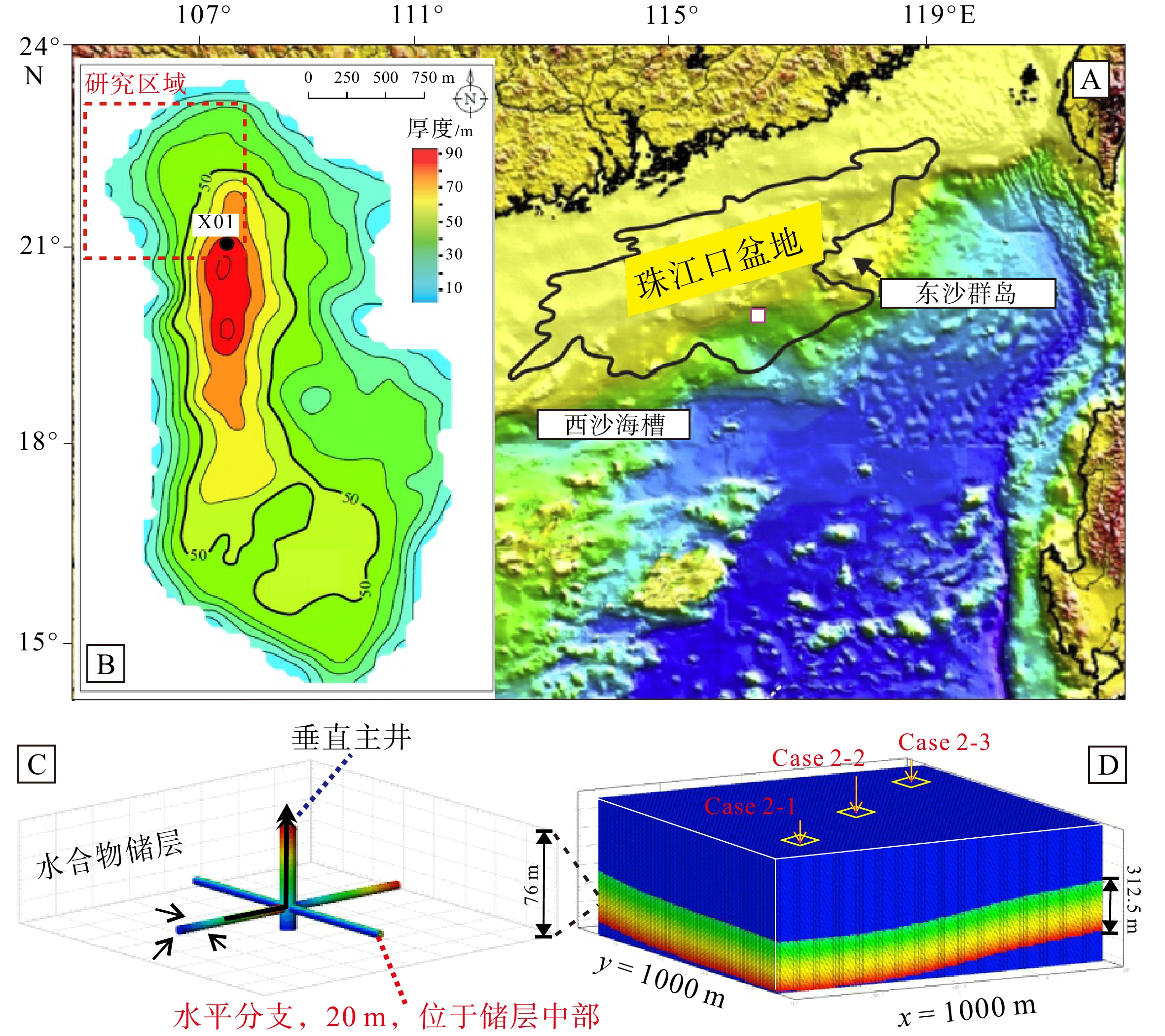
 下载:
下载:

